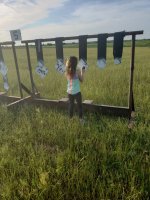I have steel targets layed out for various distances from 400-1200 yards. what i need now is visible distance numbers, like numbers "4" through "12". What is a good height for these numbers so i can get a few waterjetted and mounted up for me and my shooters to see?
- Thread starter Charger442
- Start date
You are using an out of date browser. It may not display this or other websites correctly.
You should upgrade or use an alternative browser.
You should upgrade or use an alternative browser.
So possibly 18" out to 700, then 24" out after that?
I have steel targets layed out for various distances from 400-1200 yards. what i need now is visible distance numbers, like numbers "4" through "12". What is a good height for these numbers so i can get a few waterjetted and mounted up for me and my shooters to see?
Do you want to see these numbers with the naked eye or through magnifying optics?
If looking through optics I'd guess 12" tall characters out to 500 or so and 24" tall past that?
Readable to the naked eye, I seem to recall from my NRA service rifle days that the bull on the NRA targets is 6 MOA in diameter because the naked eye can resolve that size at any distance.
So 6 MOA at 1200 yards is roughly 72" (6 feet)
Through opticsDo you want to see these numbers with the naked eye or through magnifying optics?
If looking through optics I'd guess 12" tall characters out to 500 or so and 24" tall past that?
Readable to the naked eye, I seem to recall from my NRA service rifle days that the bull on the NRA targets is 6 MOA in diameter because the naked eye can resolve that size at any distance.
So 6 MOA at 1200 yards is roughly 72" (6 feet)
How about just making a range sheet in your data book with the terrain features and targets laid out with the yardages referenced there?
You could note next to each target how tall/wide the target is in Mils/MOA next to the yardage.... if they need a way to check to be sure.
You could copy it and hand it out to other shooters as needed.
You could note next to each target how tall/wide the target is in Mils/MOA next to the yardage.... if they need a way to check to be sure.
You could copy it and hand it out to other shooters as needed.
How about just making a range sheet in your data book with the terrain features and targets laid out with the yardages referenced there?
You could note next to each target how tall/wide the target is in Mils/MOA next to the yardage.... if they need a way to check to be sure.
You could copy it and hand it out to other shooters as needed.
everything is an MOA wide at the distance, except the KYL setup at 400.
There's a private range a few hours south of me that has probably a hundred targets spread across a few hillsides. They mark the targets with like 8" tall numbers - ONLY TO DIFFERENTIATE ONE vs. ANOTHER.
My opinion:
If you put range markers on every target, you're taking out some of the challenge of ensuring you've measured distance, etc. - having an identifier helps ensure spotter and shooter are looking at the same target.
My opinion:
If you put range markers on every target, you're taking out some of the challenge of ensuring you've measured distance, etc. - having an identifier helps ensure spotter and shooter are looking at the same target.
There's a private range a few hours south of me that has probably a hundred targets spread across a few hillsides. They mark the targets with like 8" tall numbers - ONLY TO DIFFERENTIATE ONE vs. ANOTHER.
My opinion:
If you put range markers on every target, you're taking out some of the challenge of ensuring you've measured distance, etc. - having an identifier helps ensure spotter and shooter are looking at the same target.
basically i just want an identifier. could be A-L letters or numbers. ill see what i can come up with. probably 12" and 18" out of 14 gauge,.
I thought about doing this on my range. But, the way I went was to paint the targets in different hi-vis paint colors. The first hi-vis orange on the right is 400, the next white on the left is 500, the next hi-vis yellow on the left is 600, the hi-vis pink in the center is 800, etc. I have a printout map of the range and target colors, and corresponding distances I can hand out. This seems to work out pretty good on my place, and adds a little variety. This way, there is nothing out there that isn't a target. And, if you want the shooters to practice on their range-finding, don't give them the map. You just have to hit the hi-vis color targets with a coat of white paint first before you use the hi-vis paint. I don't paint the entire target anyway. I just cover the hits.I have steel targets layed out for various distances from 400-1200 yards. what i need now is visible distance numbers, like numbers "4" through "12". What is a good height for these numbers so i can get a few waterjetted and mounted up for me and my shooters to see?
Similar threads
- Replies
- 8
- Views
- 197
- Replies
- 5
- Views
- 108
Advanced Marksmanship Optimum 6.5 Creedmore bullet weight hunting small game long range
- Replies
- 3
- Views
- 338

